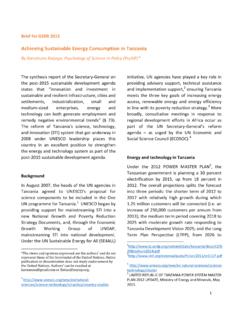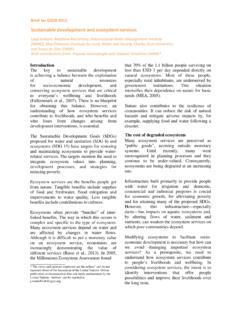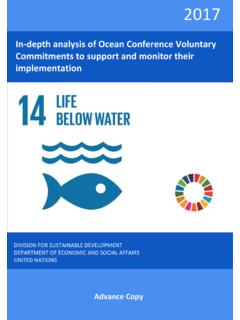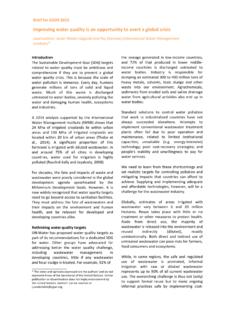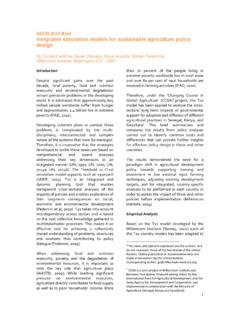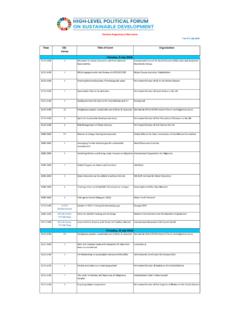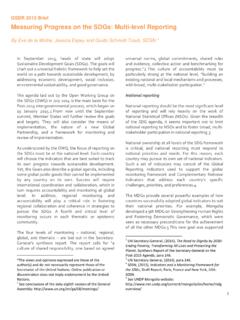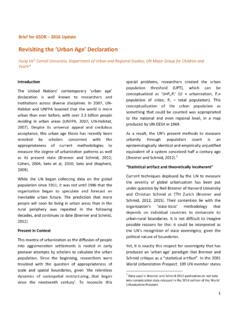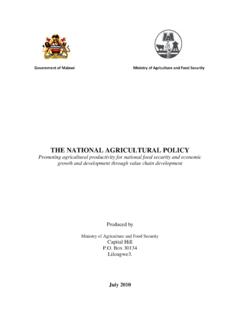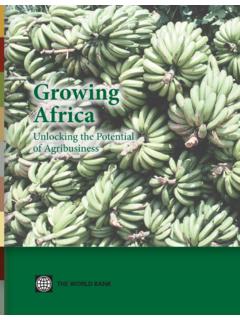Transcription of Planning and implementing action for sustainable agriculture
1 1 GSDR 2015 Brief Planning and implementing action for sustainable agriculture By the Thematic Group on sustainable agriculture and Food Systems * For global agriculture systems to produce enough food to sustainably feed nine or ten billion people by 2050, there will have to be a shift in consumer and producer behavior and a structural change toward more sophisticated technologies , information and knowledge management systems, and policies that promote market-based incentives for growth. Structured assessments for local solutions High-level SDGs for the post-2015 era will galvanize the global community, while each country and locality must choose a customized agricultural transformation path that is scalable and measurable at all levels.
2 National and local governments need to take the lead in designing and implementing roadmaps and business plans for development that are goal-oriented and appropriately account for priorities, feasibility, and costs. *The views and opinions expressed are those of the author(s) and do not necessarily represent those of the Secretariat of the United Nations. Online publication or dissemination does not imply endorsement by the United Nations. The Thematic Group is co-chaired by Achim Dobermann and Rebecca Nelson. Manager: Lauren Barredo. Editorial Consultant: Molly Slotznick. More information and full list of members available at For questions about this document please contact for general inquiries about the SDSN write to.
3 Developing such a plan typically includes five steps: background analysis of past trends and future pro-jections; definition of key problems and opportunities; assessment of different technology and policy options; estimation of outcomes and effects; and modeling of impacts on development goals and targets, including the costs and benefits across sectors. Such an assessment should devise strategies for both large commercial farms and millions of smallholders. Two primary factors that will shape tailored solutions for future agricultural development are resource endowment and access to markets (see Figure 1). Decisions should be based on a thorough understanding of the socioeconomic and biophysical factors that drive the needs of farmers, agribusi-nesses, consumers, and many other actors.
4 Guiding principles for implementing sustainable Intensification of agriculture (SIA) Although pathways will vary around the world, there are several guiding principles. Most importantly, governments and international agencies must make the sustainable development of agriculture a policy and investment priority. Moreover, though there will be tradeoffs between viable options for SIA, agricultural productivity growth in staple food crops cannot be compromised, as it is essential to eradicate poverty and hunger. SIA is an ongoing, iterative process that requires the engagement of civil society, public, and private sector stakeholders. Stakeholders must be willing to continue learning and change their behavior.
5 While all opportunities for information and technology sharing among countries and regions should be encouraged, ultimately tools and solutions must be locally tailored and context-specific. The domestic private sector, composed of millions of farmers and other local businesses, is by far the largest investor in agriculture . Programs and policies should encourage business development and public-private partnerships so that farming and agribusinesses can provide more social and economic development Figure 1 Different solutions will be required for large and small farms with varying access to resources and markets. 2 opportunities for rural communities. There must also be greater equity in access to land, inputs, and markets, especially for women and youth.
6 Multi-faceted approaches are needed to appropriately and successfully respond to the diversity of farmers environments, objectives, constraints, and incentives. Integrating agriculture with other sectors such as health, natural resource management, disaster risk reduction, gender, education, and energy will bring greater impact. Accelerated progress on SIA will require better support systems on the ground, including more professional extension systems and greater access to mobile phone technology. It will also necessitate higher coverage and quality of data on soils and weather, as well as sharing of reference research and crop information. Biophysical, economic, social, and environmental metrics must be collected in a comprehensive, reliable manner to assess different policy and technology options and evaluate their performance over time.
7 Countries should further adopt open data policies to share lessons learned. Countries must invest in increasing the resilience of crop and livestock systems to potential shocks, adapting agriculture systems to climate changes, reducing water usage, improving nutrient management and animal health, and preventing further expansion of agriculture into natural ecosystems. Small-scale food production offers a direct route to ending hunger and reducing poverty. Food producers especially those with land tenure are an army of potential environmental stewards who can protect natural resources and ecosystem services better than any government or large Ultimately, people are the primary agents of change.
8 Farmers, service providers, processors, marketers, and other local entrepreneurs must be central to the Planning of any new Designing solutions for action Practical solutions for transforming global agricultural systems must address obstacles to innovation, markets, people, and political Solutions should enable concrete action that works toward meeting one or more of the targets enumerated under the sustainable Development Goals. Some solutions will involve new technologies , business models, institutional mechanisms, and policies. Some will be globally applicable while others will be designed for a specific local context. In either case, countries must be committed to implementing solutions themselves, with the support of other countries and international agencies, and to engaging in information and technology sharing.
9 Solutions should focus on critical areas where improvements in crop, livestock, and fish productivity and natural resource management can be made relatively quickly. For example, significant gains can be realized by providing better seeds, incentivizing more efficient irrigation practices, and improving nutrient management. Equal weight should be given to solutions at the farm level and to post-harvest improvements along the food chain to the consumer. Policy requirements for successful SAI Policy and institutional reforms are necessary to align the incentives of producers and consumers toward greater sustainability. Transparency, inclusiveness, monitoring and evaluation, and continuous adaptation to changing contexts are key.
10 Sharing policy experiences and aligning relevant policies across countries and regions will also help overcome barriers to developing and adopting new technologies . Examples of solutions for early action include: increasing access to new, stress-tolerant crop varieties and/or more nutritious staple crop foods; implementing new models of agricultural extension; promoting better nutrient management, environmental stewardship, and integrated landscape management; increasing access to micro-irrigation for smallholders; strengthening livestock markets, promoting vaccinations, and doubling animal productivity; implementing climate-smart agriculture ; increasing resilience to pests and diseases; bringing innovative technologies to smallholder farmers to increase crop value, reduce post-harvest losses, and improve food safety.

